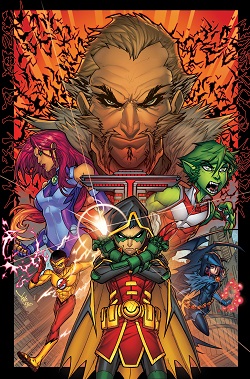
The Teen Titans are a superhero team appearing in American comic books published by DC Comics, frequently in eponymous monthly series. As the group's name indicates, the members are teenage superheroes, many of whom have acted as sidekicks to DC's premier superheroes in the Justice League. The original team later becomes known as the Titans when the members age out of their teenage years, while the Teen Titans name is continued by subsequent generations of young heroes. First appearing in 1964 in The Brave and the Bold #54, the team was formed by Kid Flash, Robin, and Aqualad (Garth) before adopting the name Teen Titans in issue 60 with the addition of Wonder Girl to their ranks.

Marvin Arthur Wolfman is an American comic book and novelization writer. He worked on Marvel Comics's The Tomb of Dracula, for which he and artist Gene Colan created the vampire-slayer Blade, and DC Comics's The New Teen Titans and the Crisis on Infinite Earths limited series with George Pérez.
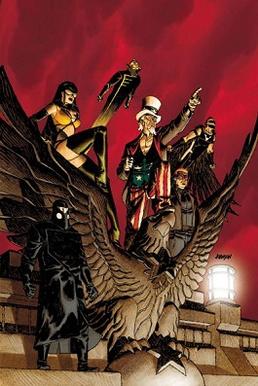
The Freedom Fighters is a superhero team appearing in American comic books published by DC Comics. The original six characters were the Black Condor, Doll Man, the Human Bomb, the Ray, the Phantom Lady, and Uncle Sam. Although the characters were created by Quality Comics, they never were gathered in a group before being acquired by DC. The team first appeared in a Justice League of America/Justice Society of America team-up, which ran in Justice League of America #107–108, written by Len Wein and drawn by Dick Dillin. Their own ongoing series premiered with Freedom Fighters #1, written by Gerry Conway and Martin Pasko, and drawn by Ric Estrada.
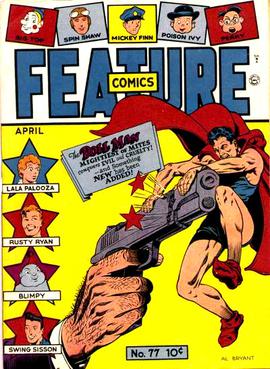
Doll Man is a superhero first appearing in American comic books from the Golden Age of Comics, originally published by Quality Comics and currently part of the DC Comics universe of characters. Doll Man was created by cartoonist Will Eisner and first appeared in a four-page story entitled "Meet the Doll Man" in Feature Comics #27. He was Quality's first super-powered character.
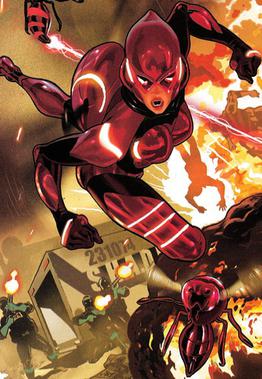
Red Bee is the name of two fictional superheroes appearing in American comic books.
Kid Eternity is a fictional character, a comic book superhero that premiered in Hit Comics #25 written by Otto Binder, drawn by Sheldon Moldoff, and published by American company Quality Comics in December 1942. All of Quality's intellectual properties were sold to DC Comics in 1956, including Kid Eternity. The character has continued to appear in DC comic books since his revival in the 1970s.

Phantom Lady is a fictional superheroine appearing in media published by Quality Comics and DC Comics. She was created by the Eisner & Iger studio, one of the first to produce comics on demand for publishers. The character's early adventures were drawn by Arthur Peddy.

The Human Bomb is a fictional superhero published by DC Comics. He first appeared in Police Comics #1, and was created by writer and artist Paul Gustavson.
"Alias the Spider" is a superhero feature from the Golden Age of Comic Books that appeared in Quality Comics' Crack Comics for nearly three years, starting with issue #1 in 1940. He was created by writer-artist Paul Gustavson.

Donna Troy is a superhero appearing in American comic books published by DC Comics. She is the original Wonder Girl and later temporarily adopts another identity, Troia. Created by Bob Haney and Bruno Premiani, she first appeared in The Brave and the Bold #60. Donna has been commonly featured in stories involving the Teen Titans, which she originally joined during their second adventure and is since depicted as a founding member of the team.
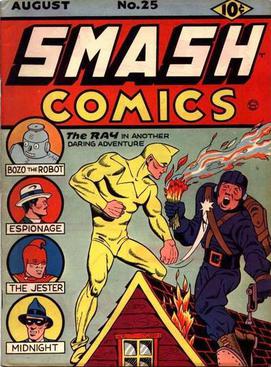
The Ray is the name of four superheroes in the DC Comics Universe. All versions of the character have the superpower of manipulating visible light in some manner.
Black Condor is the superhero name used by three different fictional characters in the DC Comics universe. All three incarnations of Black Condor have been members of the Freedom Fighters and each has been featured in Freedom Fighters comic books published by DC Comics.

Uncle Sam is a superhero appearing in American comic books published by DC Comics. Based on the national personification of the United States, Uncle Sam, the character first appeared in National Comics #1 and was created by Will Eisner.

The Blonde Phantom is a fictional masked crime fighter appearing in American comic books published by Marvel Comics. Created for Marvel predecessor Timely Comics by Stan Lee and Syd Shores, the character first appeared in All Select Comics #11, during the 1940s period fans and historians call the Golden Age of Comic Books. The heroine was so well received that the next issue was retitled The Blonde Phantom. The series continued to feature her until issue #22. She also appeared in backup stories in many other Timely comics; in Superhero Comics of the Golden Age, Mike Benton observes that "for a few months in 1948, readers could find her in seven titles on the newsstand." In The Supergirls, Mike Madrid asserted, "Once again, a capable woman hid behind a meek persona and only let her hair down, literally, to come to the aid of a man who completely ignored her unless she assumed a disguise. In a 1947 story entitled "I Hate Myself", Louise even dreams that Mark finally confesses his love for her, only to have the Blonde Phantom persona appear and steal him away."
Firebrand is a name of different characters appearing in American comic books published by DC Comics.

Al Pratt is a fictional character appearing in American comic books published by DC Comics. He is the first character to use the name Atom. He initially had no superpowers and was originally a diminutive college student and later a physicist, usually depicted as a "tough-guy" character. Al Pratt is also the father of Damage and godfather of Atom Smasher.

Wonder Boy is the name of two fictional characters who have appeared as superheroes in comics published by Quality Comics and DC Comics. The original was an alien who appeared in National Comics. The second was a time-traveler from an alternate future who appeared in Team Titans.

The Invisible Hood is a fictional superhero in the DC Comics Universe. He was originally owned by Quality Comics, but was later acquired by DC Comics, along with other Quality characters. He first appeared in Smash Comics #1, and was created by Art Pinajian, who illustrated the story under the pseudonym "Art Gordon".

Jester is a fictional character, a Golden Age superhero created by Paul Gustavson and published by Quality Comics. He first appeared in Smash Comics #22. Like most of Quality's characters, the Jester was later purchased by DC Comics and incorporated into their universe. Though little used by the company, he appeared in All-Star Squadron #31 and #60 and Starman #46. The character's last Golden Age appearance was in Smash Comics #85.

















